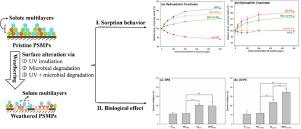Water Research ( IF 11.4 ) Pub Date : 2020-09-19 , DOI: 10.1016/j.watres.2020.116419 Wai-Kit Ho , Japhet Cheuk-Fung Law , Tong Zhang , Kelvin Sze-Yin Leung

|
Recent studies have demonstrated that weathering modifies the physicochemical properties and sorption behavior of microplastics (MPs). However, little is known about the effects of such weathering on the simultaneous sorption by MPs of different organic pollutants in multi-solute systems. In this study, the role of cosolute properties in the formation of solute multilayers with a hydrophobic primary solute (4-MBC) on pristine and various weathered polystyrene MPs (PSMPs) was examined. Three weathered PSMPs were studied namely, UV-irradiated PS (UV-PS), microbially degraded PS (MD-NPS), and UV-irradiated PS with subsequent microbial degradation (MD-UV-PS). The weathered PSMPs generally exhibited higher degree of oxygenated functionalities with less surface hydrophobicity than pristine particles. Our findings showed that the formation of solute multilayers with hydrophobic cosolutes was drastically suppressed in UV-PS due to more severe competition at hydrophobic sorption sites. Nevertheless, hydrophilic cosolutes contributed to solute multilayer formation with 4-MBC on PSMPs after UV irradiation, probably due to the stronger sorption of hydrophilic compounds to the oxidized surfaces of these particles via enhanced H-bonding. Strikingly, the sorption of 4-MBC by MD-UV-PS was notably enhanced when hydrophobic cosolutes were present. The observed synergistic sorption indicates that adhered biofilms and/or organic matter on MD-UV-PS could sorb the hydrophobic cosolute molecules, and eventually promote sorption of 4-MBC. Our further toxicity tests revealed that such solute multilayers formed on PSMPs inhibited microalgal growth. These results suggest that the fate and biological effects of MP-mediated chemical exposure could be strongly affected by weathering processes and coexistence of multiple organic contaminants in natural environments.
中文翻译:

风化对多溶质体系中聚苯乙烯微塑料的吸附行为和毒性的影响
最近的研究表明,风化改变了微塑料(MPs)的理化性质和吸附行为。但是,关于这种风化对多溶质体系中不同有机污染物同时被MP吸附的影响知之甚少。在这项研究中,共溶特性在原始和各种风化聚苯乙烯MPs(PSMPs)上与疏水性初级溶质(4-MBC)形成的溶质多层中的作用得到了检验。研究了三种风化的PSMP,即紫外线照射的PS(UV-PS),微生物降解的PS(MD-NPS)和紫外线照射的PS,其后发生了微生物降解(MD-UV-PS)。与原始颗粒相比,风化的PSMP通常表现出更高的氧化官能度和更少的表面疏水性。我们的发现表明,由于疏水吸附位点的竞争更加激烈,在UV-PS中,具有疏水性溶质的溶质多层的形成得到了显着抑制。但是,亲水性溶质在紫外线照射后在PSMP上以4-MBC促进了溶质多层的形成,这可能是由于亲水性化合物对这些颗粒的氧化表面更强的吸附通过增强的H键 令人惊讶的是,当存在疏水性溶质时,MD-UV-PS对4-MBC的吸附显着增强。观察到的协同吸附表明,MD-UV-PS上粘附的生物膜和/或有机物可以吸附疏水性固溶分子,并最终促进4-MBC的吸附。我们进一步的毒性测试表明,在PSMP上形成的此类溶质多层可抑制微藻生长。这些结果表明,MP介导的化学暴露的命运和生物学效应可能会受到自然环境中的风化过程和多种有机污染物共存的强烈影响。











































 京公网安备 11010802027423号
京公网安备 11010802027423号